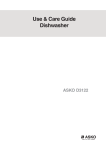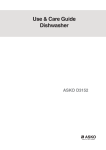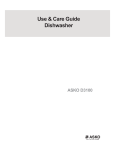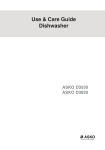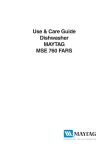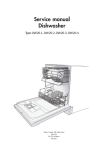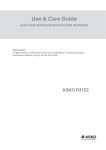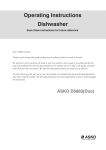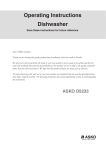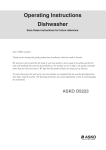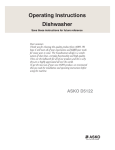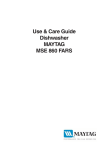Download Maytag MSE 661 Use & care guide
Transcript
Use & Care Guide Dishwasher MAYTAG MSE 661 Quick Guide 1. Loading the baskets Remove large food particles and debris. There is no need to rinse thanks to the Super Cleaning System™. 2. Dispensing dishwasher detergent The detergent compartment has a small compartment for pre-wash and one for main wash. 3. Ensure that the spray arms can rotate freely 4. Switch on the main switch 5. Close the door 6. Select program and press start For washing normally soiled mixed loads use the Normal wash program normal temperature and normal drying . with To save more water and energy use economy temperature and economy drying. Mini Program Guide Program Press Program Heavy soil Normal wash Options Quick Rinse & wash Hold -- -- How the machine works 2 Temperature Main wash 70°C 65°C 30°C -- Final rinse 70°C 70°C -- -- Contents Page Contents 3-4 Before doing your first wash 5 Read through the directions for use Take care with certain materials Check the door Check water hardness level Machines with water softener Safety General Winter storage/Transport Overfill protection Cleaning Packaging materials Scrapping 6 Changing options Do you want to load more dishes? If the machine is switched off with the main switch After dishwashing Eco-dishwashing 14 Only perform washes with a full machine Do not rinse before dishwashing Choose environmentally-friendly dishwasher detergent Child safety 7 Child-safe dishwashing Protect your children! Dishwasher detergent is corrosive Fragile dishes Fragile decoration Crystal/glass Silver Cutlery with glued handles Wood Aluminium Plastic Protect plastic goods Parts of the dishwasher 8 Standard program 16-17 Technical information 8 18-19 Baskets 9 Control panel 10 Cleaning Coarse filter Fine filter Drain pump Spray arms Door Dispenser 10 Rinse aid Pour in rinse aid Select dosage 20 Salt Pour in salt 21 Settings Setting water hardness 22 Fault indications 23 Basic Course 11-12 Load the baskets correctly Dispense dishwasher detergent Select program Options Temperature Drying Press start 15 13 3 Troubleshooting 24-26 The dishes are not clean Stains or a film on the china The china has a whitish-blue sticky film Stains on stainless steel or silver Stains which remain after dishwashing Rattling sounds during dishwashing The machine will not start Water remains in the machine Overfilling/ leakage Bad odour in the machine Performance information 27 Installation 28-32 Suggestions on positioning the dishwasher A. Built-in B. Freestanding C. Semi-freestanding Connection to water supply Connection to electricity Drainage connection Positioning the machine A. Adjusting machines with six feet (freestanding dishwasher) B. Adjusting machines with three or four feet C. Adjusting dish washers with adjustable foot Installing the plinth (Only with kick-plate as accessory) Screw the dishwasher into place Fitting strip seal (on floor plinth covering plate) NB! Not all models Setting water hardness Service & guarantee 4 33 Own comments 34 Search words 35 Before doing your first wash Read through the directions for use Check water hardness level Read through the directions for use before starting to use your machine, especially the Safety, Child Safety and Basic Course sections. Phone your local Water Board to check the water hardness in your area. This is important when dispensing dishwasher detergent and rinse aid. Take care with certain materials Machine with water softener Read the section ‘Fragile dishes’ before washing china with unglazed decoration or other household goods made of plastic, wood or crystal requiring careful treatment. Once you know the water hardness, you can set the water softener, see Settings. Before you start dishwashing, you must also fill with salt, see Salt. Check the door Check that the door of the dishwasher fits properly: open the door a little and let it go. Does it stay exactly where you released it? If not, you should check the installation instructions or consult the installer. 5 Safety General Packaging materials • Read and keep the directions for use! • Installation of water, drainage and electricity must be carried out by a qualified professional. • Do not use the dishwasher for any purposes other than those stated in these directions for use. • Do not load the dishwasher door or the dishwasher baskets with anything other than dishes. • Only use dishwasher detergent! • Place knives and other sharp objects so that they cannot cause injury to people or damage the dishwasher. Sort at source in accordance with the recommendations of your local authority. Never put dishes containing solvent residue in the machine due to risk of explosion. Neither may dishes containing ashes, wax or lubricating grease be washed in the dishwasher. Winter storage/Transport Store the machine away from frost. Avoid long journeys in extreme cold. Transport the machine in an upright position or lying on its back. Overfill protection The overfill protector starts pumping out water and closes off the water intake if the machine’s water level exceeds the normal level. If the overfill protector starts up, shut off the water supply and phone for service. See also ‘Troubleshooting’ on pages 23-25. Cleaning Only use a slightly damp cloth for cleaning around the edge of the door. Do not use a spray bottle! Water can penetrate into the lock and come into contact with the electrical components. 6 Scrapping When the time comes for the machine to be scrapped, it should immediately be rendered unusable. Remove the plug and cut off the lead as short as possible. Contact the refuse collection department or your local authority for information on the correct way to dispose of the dishwasher! The dishwasher is manufactured and labelled for recycling. Child safety! Child-safe dishwashing • Always close the door and start the program immediately once dishwasher detergent has been added. • Keep children away from the dishwasher when it is open. There might be the remains of dishwasher detergent present! • Do not allow children to use or play with the dishwasher. Always take particular care when the door is open. Protect your children! - Dishwasher detergent is corrosive! Store dishwasher detergent and rinse aid out of the reach of children! Should dishwasher detergent be swallowed, immediately drink one or two glasses of milk or water. Do not attempt to induce vomiting. Contact a doctor! Should dishwasher detergent come into contact with the eyes, rinse (for at least 15 minutes) with copious amounts of water. 7 Parts of the dishwasher* 1. Knife basket 2. Upper basket 3. Spray arms 4. Lower basket 5. Cutlery basket 6. Rinse aid dispenser 7. Dishwasher detergent compartment 8. Main switch 9. Program panel 10. Filter 11. Type plate * Details may differ depending on model and market! 1 2 3 4 5 11 8 7 10 6 9 Technical information Height Width Depth Weight Capacity** Water pressure Connection Max output Accessories * Details may differ depending on model and market! **In accordance with standard, EN 50242. ***See type plate. ****Without fitted wooden door. 8 820-870 mm 596 mm 550 mm**** 48 kg/51 kg with water softener* 12 place settings 0.03-1.0 MPa (0.3–10 kp/cm2) 1-phase, 200V/ 230 V, 50Hz/60Hz 10/10A*** 1550W/ 1900 W*** Work surface, Side panels, Anti-tilt Baskets* Upper basket 1 2 1. Wine glass shelf 2. Cup rack 3. Knife stop 4. Cutlery basket with door and folding handle 3 Lower basket Cutlery basket 4 *Details may differ depending on the model and market! 9 Control panel 3 4 1 8 5 2 7 6 1. Program selector 2. Heavy soil 3. Normal wash 4. Quick wash 5. Rinse & Hold 6. Temperature 7. Drying 8. Start/stop Dispenser 1 2 3 1. Compartment for main wash dishwasher detergent 2. Compartment for pre-wash detergent 3. Refill indicator rinse aid (not all models) 4. Rinse aid cover 5. Detergent compartment cover 4 5 10 Basic Course Below are step by step instructions to help you achieve the best possible dishwashing results. See Fragile dishes, if you want to wash articles that may be fragile. Load the baskets correctly! Your dishwasher is equipped with Super Cleaning System™. It is not necessary to rinse the dishes before washing. Simply remove large food particles and debris. Convenient and environmentally friendly! Place glasses, cups, bowls, side plates and dishes in the upper basket. Dispense dishwasher NB! detergent Ensure that all soiled surfaces face inwards or downwards! Detergent should be dispensed in accordance with the water’s hardness level. Follow the dosage instructions on the detergent package. If your dishwasher is fitted with a water softener, dispense as for soft water. Pour the dishwasher detergent into the dishwasher detergent compartment. There is one compartment for pre-wash and one for main wash, see Dispenser. Phone the dishwasher detergent manufacturer if you have any questions regarding the detergent. Place dinner plates, side plates, serving dishes, saucepans and cutlery (in the cutlery basket) in the lower basket. CAUTION! Stand the cutlery with handles downward and as spread out as possible. Ensure that spoons are not resting inside each other. NB! Do not put cutlery made of different materials, e.g. silver and stainless steel, in the same compartment (risk of stains). Protect your children! - Dishwasher detergent is corrosive! Only use dishwasher detergent Detergent for washing by hand cannot be used as the build-up of foam impedes the machine’s performance. Check that the spray arms are able to move freely. 11 Switch on the main switch Select Quick Wash if the dishes are very lightly soiled. This program is used for very lightly soiled glass and china, e.g. coffee cups. and close the door Select program Select a program by pressing the program selector one or more times until the required program is displayed. Heavy soil The Heavy soil program should be used for heavily soiled dishes, e.g. saucepans, pots and gratin dishes. If there is still space in the machine after loading such items, you can add plates etc. Normal wash Used for washing normally soiled dishes such as plates, serving dishes, cups and glasses, etc. For washing normally soiled mixed loads use the Normal wash program normal temperature normal drying . with and To save more water and energy use economy temperature and economy drying. 12 Quick wash Rinse & Hold For rinsing the dishes while waiting for the machine to be filled. If you wish to use further options continue to point 5. Otherwise you can now start the dishwasher, see point 6. Options Select options To select an option, press one of the option buttons. Temperature With the temperature option button you can select the wash temperature yourself. You can vary the temperatures as follows: Normal Economy Heavy soil: 70°C 55°C Normal wash 65°C 55°C Quick wash: 50°C 30°C Press Start The dishwasher will now start. It manages the entire wash automatically. Ensure that the door is properly closed or the machine will not start. The circle around the Start/ Stop button lights up progressively as dishwashing progresses. Changing options If you want to change program after having started the dishwasher, press the Start/Stop button for three seconds. Then select a new program and press the Start/Stop button. The field next to the button lights up if you have selected the normal temperature. The selection remains until changed. Do you want to load more dishes? Drying If you require a better drying result, you can press the Normal drying button. The field next to the button lights up. Should you require a programme with Economy drying – press again and the light will go out. Cannot be used in the Rinse & Hold programme. If the machine is switched off with the main switch Open the door; the machine stops automatically, put in the dishes, close the door and the dishwasher will continue from where it left off. (or in the event of a power cut) before the washing program has been completed, the interrupted program will continue when power comes back on. 7 After dishwashing When the dishwasher has finished, the whole circle around the Start/Stop button will be lit up. It will then only consume standing current. Should you wish to disconnect the current completely, just switch off at the main switch. Turn off the water tap if the machine is not to be used for an extended period, e.g. during holidays. Advice! For quicker drying allow the door to stand slightly ajar. 13 Eco-dishwashing Only perform washes with a full machine Put off dishwashing until the machine is full, and in this way you will save energy. Do not rinse before dishwashing Thanks to the dishwasher’s Super Cleaning System™ you do not need to rinse the dishes under running water before loading them into the machine. Choose environmentally-friendly dishwasher detergent Read environmental declarations on the package! 14 Fragile dishes A number of household goods are not suitable for machine washing. There can be many reasons for this. Certain materials cannot withstand intense heat, others can be damaged by the dishwasher detergent. Fragile decoration China with decoration on top of the glaze (the article has a rough feel) should not be machine washed. Crystal/ glass Cutlery with glued handles Certain types of adhesive cannot withstand machine washing. In such cases the handles can come loose. Wood Wooden articles should only be machine washed if they are labelled as dishwasher proof. Aluminium Place the articles so that they do not knock together during the wash. Antique and very fragile items should not be machine washed. Aluminium can be dulled by machine washing. However, good quality aluminium saucepans can be machine washed, although a reduction in lustre should be expected. Silver Plastic Silver and stainless steel items should not come into contact with each other as the silver can discolour. Certain types of plastic cannot withstand the high temperature generated in machine dishwashing. To protect plastic articles Select a program with Economy temperature and Economy drying. 15 Standard program Tested program Program Press Program Heavy soil Normal wash Normal wash Quick wash -- -- Options Quick wash How the machine works 70°C 65°C 55°C 30°C 30°C Pre-wash with SCS* (number) 2 2 -- -- -- Main wash (number) 1 1 1 1 1 Rinse & Dry (number) 3 2 2 2 2 70°C 70°C 60°C 60°C -- Yes -- Temperature Final rinse Fan Yes Yes Yes Consumption values 1. Wash time (approx. min)** 175 125 -- 55 15 1. Energy (approx. kWh) 0,9 0,9 -- 0,4 0,02 2. Wash time (approx. min)** 195 140 160 70 20 2. Energy (approx. kWh) 1,7 1,5 1,0 0,8 0,1 Water consumption (litres) 19,5 17 12 10 10 * SCS = Super Cleaning System™. ** Wash times may vary depending on water temperature, variations in voltage, etc. 1. Hot water connection approx. 60°C. 2. Cold water connection approx. 15°C. 16 Standard program Program Press Program Rinse & Hold Options -- How the machine works Temperature -- Pre-wash with SCS* (number) -- Main wash (number) -- Rinse & Dry (number) -- Final rinse 1 Fan -- Consumption values 1. Wash time (approx. min)** 4 1. Energy (approx. kWh) 0,01 2. Wash time (approx. min)** 4 2. Energy (approx. kWh) 0,01 Water consumption (litres) 3,0 * SCS = Super Cleaning System™. ** Wash times may vary depending on water temperature, variations in voltage, etc. 1. Hot water connection approx. 60°C. 2. Cold water connection approx. 15°C. 17 Cleaning Cleaning The dishwasher’s inner container is made of stainless steel and is kept clean through normal use. However, if you have calciferous (hard) water, lime deposits can form in the dishwasher. In this case, run a normal wash program with two tablespoons of citric acid in the dishwasher detergent compartment. Coarse filter Coarse filter The coarse filter collects large food particles which cannot get past the outflow pump. Lift out and empty the coarse filter as necessary. Don’t forget to replace it! Tubular strainer Fine filter The residue which collects on the fine filter is automatically rinsed off with each wash. The fine filter should still be cleaned once or twice a month. 1. Remove the fine filter by first turning the filter’s tubular strainer anti-clockwise and then lifting it straight up with the coarse filter. 2. Clean with a dishwashing brush. Ensure that the edges are properly sealed when replacing the fine filter. Fine filter Drainage pump The pump can be accessed from the inside of the machine. 1. Always remove the plug from the wall socket before you clean the pump. 2. Remove the coarse screen first by pressing together the two lugs and pulling the screen upwards. 3. Now loosen the tubular part of the screen by turning it anticlockwise and removing the fine screen. 4. Finally remove the small adapter to the left of the bottom drain. 5. It’s possible, by inserting your finger in the hole, to turn the pump impeller and remove any blockage. 6. Refit the adapter and screens. 7. Insert the plug in the wall socket. 18 Adapting piece If you still cannot start the machine and a humming noise can be heard, then the overfilling protection has been activated. • Shutoff the water • Remove the plug from the wall socket • Call Service CAUTION! Do not forget to replace the adapting piece. Spray arms The holes and bearings can occasionally become clogged. 1. Pull the lower spray arm straight up to release it. 2. Scrape away the debris with a needle or similar. The spray arms also have holes on the underside. To release the upper spray arm, the upper basket must be removed. 3. Pull out the basket and turn the basket stop outwards on both rails (see picture). The basket can now be removed. 4. Remove the upper spray arm in the same way as the lower arm and clean it. Door When cleaning the edge around the door, use only a slightly damp cloth, possibly with a little detergent. Do not use a spray bottle or similar around the door catch. This is to ensure that water does not penetrate into the door catch and come into contact with the electrical components. CAUTION! Do not use a spray bottle or similar around the door catch. Tip! In order to prevent bad odours in the dishwasher, clean the strips and corners with a dish brush and low-lather detergent. 19 Rinse aid Pour in rinse aid Select dosage Drying proceeds more quickly if you use rinse aid. The dispenser is usually set at 1= soft water. However, depending on the water hardness, it may be necessary to change the dosage. Machines with indicator on the panel When the rinse aid has run out and more is needed, the rinse aid symbol on the panel lights up*. To fill with rinse aid: 1. Turn and lift up the cover of the rinse aid compartment to the right of the dispenser. This is where you top up and set the amount of rinse aid to be dispensed in each wash. 2. Carefully pour in rinse aid up to the knob for dosage setting. Alter dosage if required. Do not forget to close the cover. *NB! After filling there may be a short delay before the signal light goes out. Machines with refill indicator There is a refill indicator in the middle of the dispenser (see picture). If the refill indicator is totally black, there is sufficient rinse aid. However, if the indicator has a more transparent appearance, you need to top up with rinse aid (see above). Open Refill indicator Closed Cover for rinse aid Open by turning and lifting the cover! 20 Open the rinse aid cover . Here you will find the dispenser’s adjustment dial. Settings 16: the harder the water, the higher the dosage. Where the water hardness exceeds 1012 odH you should use rinse aid with citric acid (acid rinse aid) if the dishwasher does not have a water softening filter. If the dishwasher has a water softening filter, dispense as for soft water. Too much rinse aid can lead to the build-up of foam. If your water is particularly soft, you can dilute the rinse aid (1 part rinse aid, 1 part water). Too much rinse aid can cause streaks on the dishes, while too little can result in water stains. Salt (applies to dishwashers with water softeners) Pour in salt Before using a dishwasher with a water softening filter, you must fill the salt compartment with salt. Use coarse salt or special salt for dishwashers. It is best to fill with salt when you are about to do a wash, as the dishwasher needs to be rinsed out immediately after filling. Proceed as follows the first time: 1. First unscrew the cover as illustrated. 2. Place the funnel, which is supplied with the dishwasher, into the compartment’s filler hole. First pour in approximately 1 litre of water. 3. Then fill the compartment with max 1.5 kg salt. 4. Wipe away excess salt so that the cover can be properly screwed into place. 5. Run a Normal wash program so that any salt in the machine is rinsed away. When the salt runs out, unscrew the cover and fill the compartment with salt. Water is only needed on the first occasion! Wipe clean and screw back in place. Run a Normal wash program so that any salt is rinsed away. Cover for the salt compartment CAUTION! Never pour dishwasher detergent into the salt compartment. The water softener will be ruined! Occasionally check to see if more salt is needed. A green indicator can be seen in the cover of the salt compartment. 21 Settings Setting water hardness If you have a dishwasher with a water softener, you may need to change the setting depending on the water’s hardness level. Phone your local Water Board to check the water hardness in your area. The dishwasher is set for low water hardness on delivery. L2 L3 L12 L7 L4 L1 L8 L11 L5 L6 L10 L9 1. Switch off the dishwasher with the main switch. 2. Press the main switch while holding in the Start/Stop button. 3. Release both buttons and the L7 light will flash. 4. Select desired setting (see table below) by pressing repeatedly on the Program button. Setting ˚dH ˚fH All extinguished 0-5* 0-9* L1 lit 6-8 9-14 L1, L2 lit 9-14 15-25 L1, L2, L3 lit 15-19 26-34 L1, L2, L3, L4 lit 20-29 35-52 L1, L2, L3, L4, L5, L11 lit 30-44 53-79 L1, L2, L3, L4, 45 and L5, L6, L11, up L12 lit 80 and up 5. Confirm your selection by pressing the Start/Stop button. You now automatically leave the settings menu and the selected setting remains until you want to change it. 22 Fault indications Indication Type of fault Action L2 flashing Too much water in the dishwasher Phone service L2 L3 L12 L7 L4 L1 L8 L11 L6 L5 L10 L9 23 Troubleshooting Problems The dishes are not clean. Possible causes Action • The spray arms are not rotating. • Lift off the arms and clean. • Old dishwasher detergent. NB! Detergent is a perishable. • Avoid large packs. • Incorrect dosage of detergent. • Dispense according to the level of water hardness. • Insufficiently powerful dishwashing program. • Select the Temperature normal option or switch to a more powerful program. • Incorrect program chosen. • Change to a more intensive program. • Incorrect loading of the dishwasher. • Do not cover china with large bowls or similar. •Avoid placing very tall glasses in the corners of baskets. Stains or a film on the china. 24 • Glasses and cups have tipped over during the wash. • Load the china securely. • Dishwasher fitted with water softener is leaking salt. • Check that the cover of the salt compartment is properly screwed on. Otherwise phone for Service. • Incorrectly set water softener. • See the chapter on water softeners. • Incorrectly set rinse aid dispenser. • See the chapter on rinse aid. • The salt compartment is empty. • Top up with salt. • Phosphate-free detergent in combination with hard water. • Change detergent. • Too high a temperature and/or too much detergent can cause etching on (crystal) glass. Unfortunately this cannot be remedied, only prevented! • Wash (crystal) glass at a low temperature and dispense dishwasher detergent with care. Contact the dishwasher detergent manufacturer. Problems Possible causes Action The china has a whitishblue sticky film. • Too high dosage of rinse aid. • Reduce dosage. See the chapter on rinse aid. If the water is very soft, you could try diluting the rinse aid (1 part rinse aid, 1 part water). Stains on stainless steel or silver. • Certain food remnants such as mustard, mayonnaise, lemon, vinegar, salt and dressings can cause stains on stainless steel if allowed to remain for any length of time. All stainless steel can mark silver if allowed to come into contact during the dishwashing process. Aluminium can also cause stains on dishes. • Rinse off food residue of this type if you do not intend to start the dishwasher immediately. • Seperate your cutlery into the varians compartments in the basket. Make sure silver and stainless steel are not together. Stains which remain after dishwashing. • Lipstick and tea can be difficult to remove. • Change to a detergent with bleach. Rattling sound during dishwashing. • The dishes are not properly loaded or the spray arms are not rotating. • Check that the china is loaded securely. Spin the spray arms to make sure that they rotate. The machine will not start. • You have forgotten to switch on the main switch. • Check • The door is not properly closed. • Check • A fuse has blown. • Check • The plug is not plugged in. • Check • The water tap is off. • Check To restart the machine, press Start/stop for 3 seconds. Now select a new programme and press Start/stop. • Overfilling/leakage • A droning sound (drainage 1. Close the water tap. 25 Problems Action pump) can be heard from the machine, this does not stop when the power is switched off using the main power switch. 2. Pull out the plug. 3. Call a service engineer • Obstruction in the drain hose. • Disconnect the drain hose where it is connected to the sink’s water trap. Check that no debris has become stuck. Is the cone-shaped part of the pipe cut so that the diameter is at least 16 mm? • Kinks in the drain hose. • Check that the hose is free from kinks or sharp bends. • The filters are clogged. • Clean out the coarse filter, the fine filter and the filter. • Items in the drain pump. • Clean out the drain pump. See chapter on cleaning Bad odour in the machine • Dirt along the strips and in corners • Clean with a dish brush and low-lather detergent. The dishes are not sufficiently dry • Drying power too low. The machine is not fully loaded. The rinse aid has run out or the set dose is too low. • Activate the Normal drying option (not all models). Put a full load in the machine. Replenish rinse aid or increase the dose of rinse aid. Open the door slightly once the program has finished. Water remains in the machine. 26 Possible causes Performance information Test dosage Heavy soil/Normal wash Main wash 25 gram Standard detergent. Rinse aid dosage 1. Energy labelling Europe: Dishwasher program: Normal wash, 55°C, economy drying Program time: Connection: EN 50242 160 minutes. Cold water Test method noise measurement: IEC-704-3 Example of dishwasher loading EN 50 242 EN 50 242 Technical information Height: Width: Weight: Capacity: Water pressure: Connection: Output: 820-870 mm 596 mm 48 kg* 51 kg with water softener* 12 IEC place settings 0.03-1.0 MPa 0.3-10 kp/cm2 (Bar) 3-100 N/cm2 See type plate See type plate *The weight can vary due to varying specifications. 27 Installation Suggestions for positioning the dishwasher Built-in installation The dishwasher can be built in, fully freestanding or semi-freestanding. CAUTION! Connection to electricity, water and drainage must be carried out by a suitably qualified person. 570 20 550 820-870 820870 100150 570 600 A. Built-in The dishwasher can be built in under a worktop with a working height of 820 - 870 mm. The width measurement must be at least 600 mm. For additional measurements, see picture. B. Freestanding A freestanding dishwasher must be fitted with anti-tilt. This comprises two fastening irons which are screwed into place as illustrated. The dishwasher is then pushed in so that the fastening irons grip onto the rear feet. The dishwasher cannot now tilt in the event a load is placed on the open door. If the dishwasher is to be fully freestanding, both side panels and the work top should be fitted. These accessories can be purchased where you purchased the dishwasher. 0 -23 175 50 50-10 5 Freestanding installation 413 45 5- 47 5 600 CAUTION! Tip! A machine with side panels and a counter top (freestanding) can, of course, also be installed as a built-in unit. C. Semi-freestanding If the dishwasher is positioned so that either side is visible, a side panel can be fitted. These accessories can be purchased where you purchased the dishwasher. 28 A fully freestanding dishwasher must be fitted with anti-tilt. Connection to water supply Connection to drainage There must be a shut-off tap on the water supply pipe. The shut-off tap should be positioned above the work surface or at the front of the sink unit. When the drain hose is routed to a connection nipple at the sink’s water trap (see illustration 1), note that the hose must be fastened level with the underside of the sink unit – otherwise the dishwater from the sink can run down into the dishwasher. The drain hose is threaded onto a cone-shaped connecting pipe at the sink unit’s water trap. The cone-shaped pipe must be cut to an internal diameter of at least 16 mm. For other alternative connections, see illustrations 2 and 3. The water supply pipe has a connection with a 1/2” or 3/4” internal thread depending on country. When the installation is complete, the shutoff tap should be opened to allow the pressure to settle for a while and to check that all connections are tight. Connection to electricity A dishwasher fitted with a lead and plug must be connected to an earthed socket. Repairs and maintenance affecting safety or performance must be carried out by a qualified professional. Technical data See the type plate on the right hand side of the door. CAUTION! The lead must be disconnected or the socket voltage-free while the work is carried out! The drain hose may be lengthened by a maximum of 3 m (the total length of the drain hose may not exceed 4.5 m). Any connections and connecting pipes must have an internal diameter of at least 16 mm. However, the drain hose should ideally be replaced with a new hose without joins. No part of the drain hose may be more than 950 mm above the bottom of the machine. The hose must not be routed directly to the floor drain or similar. In such cases, the hose can act as a siphon and empty the dishwasher. The hose must always discharge at least 350 mm above the bottom of the machine. Connection to drainage NB! Illustration 2 Max 3 m The hose must be fastened level with the underside of the work surface. Illustration 1 Max 950 mm Min 350 mm Illustration 3 Max 950 mm Max 950 mm Min 350 mm Min 350 mm Details may differ depending on the model and the market! 29 Positioning the machine A. Adjusting machines with 6 feet (freestanding dishwasher) 1. Adjust the height of the dishwasher with the four steel feet. 2. Lock the feet with the nuts. NB! The dishwasher must not be allowed to lean more than 5 mm. Stålfötter Steel feet 5. Check that the height of the machine corresponds to the height from the floor to the underside of the work surface. Tighten the locking nuts (locking nut) on the rear feet. 6. Push the dishwasher into place. 7. Finely adjust the front feet (the machine may lean max. 5 mm) and tighten the locking nuts. C. Adjusting dishwashers with adjustable foot 1. Start by measuring the height from the floor to the underside of the work surface. 2. Install the sliding feet on the dishwasher. 3. After the steel feet have been adjusted, screw down the two rubber feet tightly against the floor. The rubber feet now work as anti-tilt protection. B. Adjusting machines with three or four feet 1. Start by measuring the height from the floor to the underside of the work surface. 2. Install the sliding feet on the dishwasher. 3. Measure the height from the floor to the top edge of the dishwasher. 4. Adjust all the feet by screwing them clockwise to raise or anti-clockwise to lower. 30 3. Measure the height from the floor to the top edge of the dishwasher. 4. Tilt the dishwasher forward a fraction and roughly adjust the rear foot by screwing the set screw at the front clockwise to raise or anti-clockwise to lower (illustrated below). Use a broad screwdriver or a hexagonal head screwdriver. 5. Adjust the front feet by turning them clockwise to raise or anti-clockwise to lower. 6. Check that the height of the machine corresponds to the height from the floor to the underside of the work surface. 7. Push the dishwasher into place. 8. Finely adjust the feet (the machine may lean max. 5 mm) and tighten the locking nuts on the front feet. Not all models To prevent kinks, pull the drain hose and the connecting pipe. Fitting fixed kick-plate Installing the plinth (Only with kick-plate as accessory) The dishwasher has two kick-plates (some models). The taller one should be used if the machine is to be 850 - 870 mm high and the depth of the plinth can be varied between 45 - 105 mm. The lower one is to be used if the machine will be 820 - 845 mm with a plinth depth of between 50 - 105 mm. Attach the enclosed felt insulation to the kickplate (some models). Set the correct plinth depth as follows: 1. Bring the grey hooks towards each other and pull out the brackets as far as required. Press in the catches so that they lock the brackets in place. 2. Suspend the kick-plate from the brackets by pushing into the slots. Screw the dishwasher into place The enclosed plastic plugs are used for covering the screw holes if the dishwasher is to be screwed at the sides. After fixing check that the front feet are in contact with the floor. Fitting strip seal (on floor plinth covering plate) Proceed as follows: 1. Remove the plastic plinth by gripping with both hands under the plastic plinth(A), and break outwards and upwards. B A 2. Undo the two screws on the covering plate(B). 3. Glue the accompanying rubber strip(C) to the underside of the covering plate (against the floor). 4. Screw the covering plate back into place. Adjust the covering plate so that the rubber strip is just in contact with the floor. x x C 5. Replace the plastic plinth 31 Setting water hardness If you have a dishwasher with a water softener, you may need to change the setting depending on the water’s hardness level. Phone your local Water Board to check the water hardness in your area. The dishwasher is set for low water hardness on delivery. L2 L3 L12 L7 L4 L1 L8 L11 L10 L5 L6 L9 1. Switch off the dishwasher with the main switch. 2. Press the main switch while holding in the Start/Stop button. 3. Release both buttons and the L7 light will flash. 4. Select desired setting (see table below) by pressing repeatedly on the Program button. Setting ˚dH ˚fH All extinguished 0-5* 0-9* L1 lit 6-8 9-14 L1, L2 lit 9-14 15-25 L1, L2, L3 lit 15-19 26-34 L1, L2, L3, L4 lit 20-29 35-52 L1, L2, L3, L4, L5, L11 lit 30-44 53-79 L1, L2, L3, L4, 45 and 80 and L5, L6, L11, up up L12 lit 5. Confirm your selection by pressing the Start/Stop button. You now automatically leave the settings menu and the selected setting remains until you want to change it. 32 Service & guarantee Service Guarantee Before calling for service, check to see whether the faults is due to something that you can put right yourself. See Trouble shooting pages 24-26. For guarantee details, see the guarantee card. 33 Own comments 34 Search words C Child safety 5, 7 Crystal 5, 14 D Dishes 5, 6, 11, 12, 14 Dishwasher detergent 6, 8, 10, 11, 13, 17, 20 Drainage 27, 28 E Energy 13, 26 Environment 36 G Guarantee 32 L Lime 17 P Plastics 5, 14 Programs 12, 15, 16 Q Quick Guide 36 R Rinse aid 5, 8, 10, 18, 19 S Safety 5, 6, 28 Salt 5, 20, 21 SCS 15 Service 6, 22 Settings 21 Silver 11, 14 W Washing programs 12, 17 Water hardness 5, 21, 31 Water softener 5, 8, 11, 20, 21, 26, 31 Winter storage 6 35 Art. No.: 80 783 73. Rev. 02. We reserve the right to make changes. Printed on environmentally-friendly paper which meets the demands of Friends of the Earth and the Swedish Society for Nature Conservation. 36




































